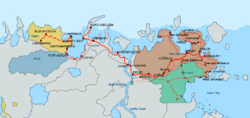Trans-Keltian Express
 logo of the Trans-Keltian Express | |||||||||||||||||||||||||||||||
| Overview | |||||||||||||||||||||||||||||||
|---|---|---|---|---|---|---|---|---|---|---|---|---|---|---|---|---|---|---|---|---|---|---|---|---|---|---|---|---|---|---|---|
| Status | Operational | ||||||||||||||||||||||||||||||
| Location | Keltia | ||||||||||||||||||||||||||||||
| Termini |
| ||||||||||||||||||||||||||||||
| Stations | 10 (5 in Mercury, 5 in Normark) | ||||||||||||||||||||||||||||||
| Routes | Mercury to Nordiskehjem (Line TK1) | ||||||||||||||||||||||||||||||
| Operation | |||||||||||||||||||||||||||||||
| Opened | 1694 AN | ||||||||||||||||||||||||||||||
| Closed | 1737 AN | ||||||||||||||||||||||||||||||
| Owner | Trans-Keltia Railways | ||||||||||||||||||||||||||||||
| Operator(s) | Various | ||||||||||||||||||||||||||||||
| Depot(s) |
Mercury, Mercury Požun, Mercury Hagbard, Normark | ||||||||||||||||||||||||||||||
| Technical | |||||||||||||||||||||||||||||||
| Line length | 7,158km (4,448 mi) | ||||||||||||||||||||||||||||||
| No. of tracks | Double track throughout | ||||||||||||||||||||||||||||||
| Track gauge |
1,435 mm (4 ft 8 1⁄2 in) standard gauge | ||||||||||||||||||||||||||||||
| Electrification | 25kV 60Hz AC OHLE | ||||||||||||||||||||||||||||||
| Operating speed | 350 km/h | ||||||||||||||||||||||||||||||
| Route | |||||||||||||||||||||||||||||||
| Map |
 | ||||||||||||||||||||||||||||||
| Route |
| ||||||||||||||||||||||||||||||
The Trans-Keltian Express was an international railway route initially spanning the northern regions of Keltia. Construction began with a high-speed line between Mercury and Hagbard, thus connecting the Mercurian capital with all major cities of Normark through Normark's internal railway system, up and to Nordiskehjem in the north-west.
For Normark, the project included building a railway crossing in the form of a tunnel under the Norse Gate, thus connecting Hagbard in the east of the Strait of Haifa with Signe in the west, and the rest of Normark.
An extension of the route to Vegno was completed in 1732 AN, however, following the fall of Normark in 1737, the route was closed for international travel.
Route
The Trans-Keltian Express route begins in Nordiskehjem, moving southwards towards Elijah's Rest, where it turns south-eastwards to cross the span of Normark. The line passes beneath the Norse Gate via a tunnel, then continues southwards towards Hagbard. On leaving Hagbard, the line turns sharply towards the east, where it heads towards Mercury.
After crossing the Mercurian border into Osktrava, it winds its way through the valley where the Výsoký Východný and Nízky Východný meet. As it heads towards the city of Požun, it runs alongside the shores of Bavičký pleso, before passing through a tunnel underneath the northern face of Čistý Štíť. The route arrives in Požun, where it continues north-eastwards towards Košťova, approximately following the route of the Rýchla. After Košťova, the line continues into Moorshire, bypassing the city of North Eastmoor to the south, and instead taking a sharp turn northwards towards Harlby. The route passes through Nafferton without stopping, on its journey towards Taylor. The line is planned to extend into the central station within Taylor, which would force the train to reverse out of the station on the last leg towards Mercury, where it terminates.
Construction
The initial phase of construction began in 1686 AN with the extension of Mercury's existing network towards Castilona and Qavaqaqqaqqaniitqeqertaq. The second phase, the westbound extension of the line from Požun towards the border with Normark, began in 1690 AN, and was completed in 1694 AN.
Proposed extensions
The government of Mercury have proposed an extension to the route, tentatively referred to as TKE-2, which would extend south from Mercury through Tow Law and West Grinstead, before turning west into Ostland, reaching the capital Reichsborg, then heading south towards Arevacia and Ciudad de Anahuaco. The extension would ultimately aim to connect to Nouvelle Alexandrie, however the exact route at this point is as yet undetermined.
Following a series of natural disasters and regional conflicts, Moorland emerged as the stabilizing force within the area and opted to take the helm with the TKE-2 project. After expanding the territory of Nevermoor westward around the Dunn Mountains, survey teams began mapping out a new route for the TKE extension. This route would take it along the River Lorne valley to the city of Blackend, then east towards Raveness. A spur would connect Raveness and eastern cities such as Newcastle-Upon-Eastmoor. The main route would continue south into Burwood, over to St Joseph's, and then south to Fort Hunter and the Ports of Newhaven. From there the line would be picked up by Anahuaco and head south to Nouvelle Alexandrie. Work on the Moorland route is expected to begin in 1729. By VII.1729 work was completed on the Dunn Mountains Viaduct, a major bypass connector into Moorland. Engineers expect the rail to reach Raveness by the end of the year. In late 1730 the rail line extension had exceeded expectations and been extended to Raveness, then south to St. Joseph's and Kingsburgh, with work on the southern tier ongoing to Fort Hunter, which is expected to take another year or two. However, rail service between Mercury and Moorland officially opened in XI.1730 with passenger stations now readily available as far south as Ostkirk.
By the summer of 1731, the rail route had reached the city of Evesden. The route would now be directed southeast towards to Fort Hunter and eventually the Ports of Newhaven, where it would finally connect with Anahuaco. As mid-1733 rolled around, the rail line had been completed as far as Fort Hunter.

Vegnese route
In 1730 AN the President of the Republic of Vegno, Antonio Visciglia, together with the Governor of San Lucido, Raphael Bullman, publicly expressed their desire to also connect the main cities of Vegno on Keltia via the Trans-Keltian Express.
The vegnese proposal, subsequently accepted by Trans-Keltia Railways, provided for the line to be extended westwards from its final terminus in Normark to the city of Port Aerla in Aerla, and then enter the vegnese territory.
According to the project, the line should have had four stops in Vegno, including the cities of Santa Markovia, Commenda, Nuova Cossa and Cammarata, which would have represented the new terminus of the Trans-Keltian express.
The project was welcomed with great enthusiasm by the other neighboring nations and the works in Vegno officially started in XIII.1730 AN.
The timetable of the works foresees the end of these in 1732 AN, with a gradual opening of the line in two moments: at the end of 1731 AN the stops of Santa Markovia and Commenda will be opened and at the end of 1732 AN those of Nuova Cossa and Cammarata.